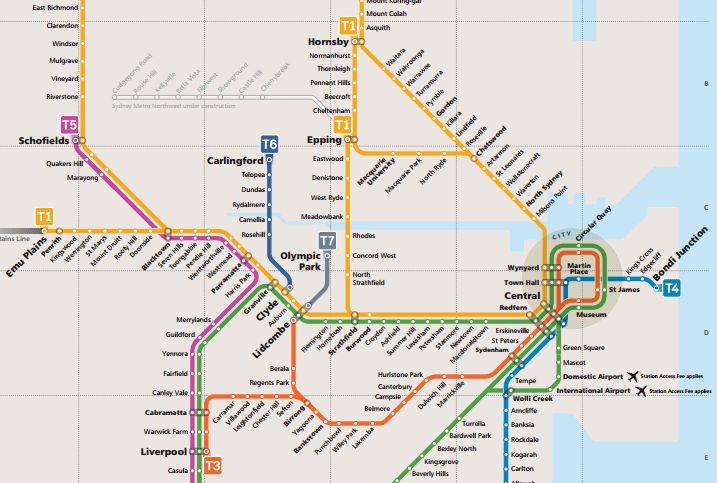After Melbourne Metro: should we rebrand the rail network?
The Melbourne Metro Rail project will be the catalyst for a big shakeup in the way our rail network operates once it's operational in 2026 and the way we refer to individual rail lines will become meaningless for half the network around the same time.
It's clear that from 2026 after the construction work has been completed for the Melbourne Metro Rail project that there will be not one but two cross-town rail routes: Pakenham/Cranbourne-Sunbury and Werribee/Williamstown/Laverton via Altona to Sandringham.
Say those two groups of rail lines out aloud… "Pakenham Cranbourne Sunbury Line" and "Werribee Williamstown Laverton via Altona Sandringham Line". They're excessively long, convoluted, potentially confusing and would be meaningless to those who are not familiar with the system, from interstate or farther afield.
The "if it isn't broke, why fix it?" crowd might feel their noises are being put out of joint but I think the nomenclature of our rail lines needs an update.
The practice of referring to a rail line by its terminus makes sense if all the services run to the end of the line but increasingly this is not going to be the case as the Melbourne Metro project's 'wider network enhancements' and proposed service plan paint a picture of a larger amount of services running shorter distances from mid-points along respective rail lines.
Colours, letters and numbers: the way forward?
Continental Europe perhaps shows us the best way forward. Take Paris for example, the metro lines which are concentrated around the centre of the city are all numbered and the RER lines which connect Paris with its suburbs are lettered. In fact the letter plus number system of Paris' RER I think is how we should rebrand rail lines.
Like how the Melbourne network will eventually operate, Paris' RER consists of five trunk lines and all of them eventually split into branches. When Melbourne Metro starts operating there will be one long trunk from Sunbury to Dandenong where the trunk will then split into two branches; ditto a trunk from Sandringham to Newport and then three branches to Werribee, Williamstown and Laverton via Altona.
Every trunk line on Paris' RER network has a distinct colour, letter and a number which corresponds to a terminus on the respective branch line.
The RER A (red) line in the map above has a single trunk through central Paris and then 5 numbered branches beyond; and also note that odd numbers for RER A correspond to branches terminating in the west of the city and even numbers correspond to branches terminating in the east.
How might this work in Melbourne?
Passengers will still need to look at the passenger information displays in order to ascertain which train is arriving and whether it is the train they need to jump on. Other big city 'metros' generally do not have branches therefore - for the most part - every train which arrives at the platform you are standing on goes to the same terminus; the passenger's mental effort only has to focus on getting to the correct platform and just hop on the next train.
As there will be timetabled short-running trains operating to and from the new infrastructure to be built as part of the Melbourne Metro project perhaps a way to incorporate this detail into an easily understood identifier is to take the example of the Paris RER trunk/branch numbering and give all the services that will run on the short-stopping lines a letter and number as well.
Pakenham/Cranbourne-Sunbury line would become:
Colour: Red
Letter: A
Numbers (branch/terminus):
West
- A1 (Sunbury)
- A3 (Watergardens)
- A5 (WEST FOOTSCRAY)
- A7 (Melton) - when it is eventually electrified and brought into the metro network
- A9 (TULLAMARINE Airport) - when it is eventually built
East
- A2 (Pakenham)
- A4 (Cranbourne)
- A6 (Dandenong)
- A8 (Westall)
Station signs and platform passenger information displays would be coloured the same as it would be on a map but also list the services that stop on that platform. For example, a station platform sign at Carnegie on platform 1 (westbound) would list A1, A3, A5 and A7 as services which stop at that platform, likewise on the opposite platform 2 (eastbound) A2, A4, A6 and A8 would be listed as services which stop at that platform.
Platform passenger information displays and the equivalent displays located at the front, rear and side of each train would carry the coloured letter + number code along with the familiar destination name (i.e. "A2 Pakenham", "A3 Watergardens") and automated announcements would also prepend the letter + number code to the familiar destination name.
Line maps would list the station name and the letter + number code of the various train services which stop at that station so that when an unfamiliar user is determining their route via a map on a smartphone, a line 'strip' map on the platform or on a network-wide map they can quickly and easily judge which trains will get them to their destination.
Agree? Disagree? What other city rail naming conventions and wayfinding techniques might we use as inspiration?
